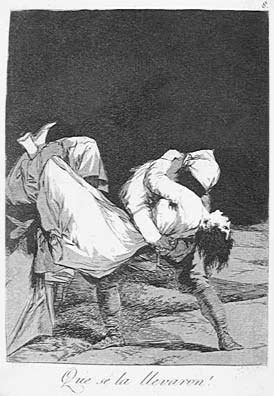To coincide with the 200th anniversary of the events of May 1808 and the start of the Spanish War of Independence, the Museo del Prado presented a major exhibition devoted to Goya, Goya in Times of War.
It focused on the two great canvases of the
2nd of May 1808
and

3rd of May 1808.
The exhibition included more than 65 paintings loaned from other institutions and private collections, including

Majas on the Balcony

and Portrait of the Marchioness of Montehermoso, both from private collections;

Friar Pedro de Zaldivia clubs Maragato the Bandit from The Art Institute of Chicago;

The Capture of Christ from Toledo Cathedral, and a group of nine works loaned by the Real Academia de Bellas Artes de San Fernando, Madrid. The latter were essential to the theme of the exhibition and were presented for the first time within the context of Goya's artistic development. Goya in Times of War was the largest exhibition devoted to the artist since the one held at the Prado in 1996.
The exhibition opened in the last years of the 18th century when Goya embarked on a new phase in his career, marked by greater creative freedom and by stylistic and conceptual advances. This phase would culminate with the series of etchings known as Los Caprichos of February 1799

One of Goya's 80 Caprichos - "The Sleep of Reason Produces Monsters"

¡Que se la llevaron! (They carried her off). Francisco Goya. Etching, aquatint. 1797. 8 7/16 x 5 7/8 inches. Plate number 8 from Los Caprichos.

and with the painting of The Family of Charles IV of 1800.
It concluded in 1819, the year in which Goya painted his last public work:
The Communion of Saint José de Calasanz.
With regard to the artist's personal life, during these years he suffered two serious illnesses. The one of 1792 to 1793 left him deaf, and was followed by a period of recovery in which Goya advanced towards greater artistic independence. The second illness of 1800 again brought him almost to the point of death, while politically this period coincided with Ferdinand VII's abolition of the Constitution in 1812.
These twenty-five years of Goya's life saw political changes in Spain that would be of enormous historical and social importance. On the international scene, the French revolution and its different phases, the Convention, the Terror, the Thermidorean reaction and the evolution towards the Consulate and the Empire profoundly affected Spain during the reign of Charles IV and María Luisa and their Chief Minister Godoy. With the exception of a brief period under Jovellanos, the latter was in power until the key year of 1808. The Spanish War of Independence was the leading event of the first third of the 19th century. In addition to the invasion of Spanish soil by foreign troops and the ensuing slaughter and famine, the war resulted in political and social liberalisation in the two Spains that emerged from the conflict: the free Spain, based in Cadiz following the proclamation of the Constitution in 1812, and the occupied Spain, based in Madrid under the enlightened government of King José Bonaparte and his pro-French collaborators. The return of Ferdinand VII in 1814 resulted in the abolition of the Constitution and in political repression under the king's new absolutist rule.
Between 1795 and 1819 Goya's art and life evolved from a court setting, fully confirmed by his appointment as First Court Painter in October 1799 - a post that placed his services at the disposition of the monarchy and the aristocracy - towards the freedom and independence of his later years when he was primarily interested in the study of human nature and its conflicts. The work he produced for the king and court evolved towards a more intimate type of output, increasingly focused on portraits of his friends and on independent paintings in which he openly expressed progressive or satirical ideas that criticised evil, human ignorance and society's defects and woes. During this crucial period Goya primarily focused on drawing and printmaking, producing print series such as Los Desastres de la Guerra, La Tauromaquia and Los Disparates, as well as drawings of a wide variety of subjects including the Inquisition and the repression as well as deception and madness, along with other more optimistic subjects that reflected the society around him.
The exhibition was divided into various sections which correspond to different phases of Spanish history during this period and which provide a framework for Goya's life and the evolution of his art. It brought together almost 200 works that have been carefully selected using the criteria of appropriateness for the subject in hand, outstanding artistic quality and state of conservation, as well as definite autograph status. Paintings in different genres, prints and drawings enabled the visitor to learn more about Goya at this period, particularly the ideas behind his images and the unique way that he conceived and formulated them.